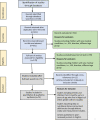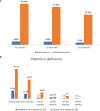Exploring disparities in malnutrition among under-five children in Nigeria and potential solutions: a scoping review
- PMID: 38249616
- PMCID: PMC10796494
- DOI: 10.3389/fnut.2023.1279130
Exploring disparities in malnutrition among under-five children in Nigeria and potential solutions: a scoping review
Abstract
Introduction: Triple burden of malnutrition in children remains a significant public health issue. This scoping review aims to assess the information on undernutrition, micronutrient deficiencies and the quality of complementary feeding in various regions in Nigeria.
Methods: A literature search was conducted using PubMed and Google Scholar databases from January 1, 2018 to January 31, 2023 to include studies focusing on 0 to 5 years old children in Nigeria, reporting data on nutritional status, nutrient deficiencies, and published in English.
Results: 73 out of 1,545 articles were included. Stunting remained alarmingly high ranging from 7.2% (Osun, South West) to 61% (Kaduna, North Central), while wasting varied from 1% (Ibadan, South West) to 29% (FCT Abuja, Central) and underweight from 5.9% (Osun, South West) to 42.6% (Kano, North West) respectively. The overall prevalence of anemia and vitamin A deficiency ranged between 55.2 to 75.1 % and 5.3 to 67.6%, respectively. Low rates of achieving minimum dietary diversity and minimum meal frequency were reported across different states depicting the suboptimal quality of complementary feeding. The prevalence of overweight/obesity ranged from 1.5% (Rivers, South South) to 25.9% (Benue, North Central).
Conclusion: Multiple early childhood malnutrition issues exist with a wide disparity across states in Nigeria, particularly in the Northern region. Targeted nutrition interventions must be implemented to improve the situation.
Keywords: Nigeria; children below 5 years; multiple undernutrition issues; poor quality of complementary feedings; targeted interventions.
Copyright © 2024 John, Poh, Jalaludin, Michael, Adedeji, Oyenusi, Akor, Charles, Buthmanaban and Muhardi.
Conflict of interest statement
VB and LM are employees of FrieslandCampina. The remaining authors declare that the research was conducted in the absence of any commercial or financial relationships that could be construed as a potential conflict of interest.
Figures





Similar articles
-
Nutritional status of school-age children (5-19 years) in South Asia: A scoping review.Matern Child Nutr. 2024 Apr;20(2):e13607. doi: 10.1111/mcn.13607. Epub 2023 Dec 14. Matern Child Nutr. 2024. PMID: 38095279 Free PMC article.
-
Nutritional status and dietary intake among Nigerian adolescent: a systematic review.BMC Public Health. 2024 Jul 2;24(1):1764. doi: 10.1186/s12889-024-19219-w. BMC Public Health. 2024. PMID: 38956547 Free PMC article.
-
The nutritional status of children living within institutionalized care: a systematic review.PeerJ. 2020 Feb 6;8:e8484. doi: 10.7717/peerj.8484. eCollection 2020. PeerJ. 2020. PMID: 32071812 Free PMC article.
-
Breastfeeding Practices, Infant Formula Use, Complementary Feeding and Childhood Malnutrition: An Updated Overview of the Eastern Mediterranean Landscape.Nutrients. 2022 Oct 9;14(19):4201. doi: 10.3390/nu14194201. Nutrients. 2022. PMID: 36235853 Free PMC article. Review.
-
Prevalence and patterns of anthropometric failure among under-five children in Nigeria: Evidence from the National nutrition and health survey, 2018.Afr J Reprod Health. 2022 Nov;26(11s):54-61. doi: 10.29063/ajrh2022/v26i11s.5. Afr J Reprod Health. 2022. PMID: 37585124
Cited by
-
Soil-transmitted helminth infections and nutritional indices among children (5-9 years) and adolescents (10-12 years) in Calabar, Nigeria.BMC Public Health. 2025 Jan 2;25(1):1. doi: 10.1186/s12889-024-21210-4. BMC Public Health. 2025. PMID: 39743623 Free PMC article.
-
Gendered Social Norms, Exceptions, and Sanctions: Implications for Maternal, Infant, and Young Child Nutrition in Nigeria.Curr Dev Nutr. 2024 Dec 10;9(1):104524. doi: 10.1016/j.cdnut.2024.104524. eCollection 2025 Jan. Curr Dev Nutr. 2024. PMID: 39866175 Free PMC article.
-
Availability, Affordability, Awareness, Preferences and Nutritional Impact of Biofortified Crops in Nigeria.Nutrients. 2025 Mar 15;17(6):1036. doi: 10.3390/nu17061036. Nutrients. 2025. PMID: 40292489 Free PMC article.
-
Nutritional status of HIV-infected children at Federal University Teaching Hospital, Owerri, Nigeria: A prospective analysis of rural and urban dwellers.Medicine (Baltimore). 2024 Aug 23;103(34):e39413. doi: 10.1097/MD.0000000000039413. Medicine (Baltimore). 2024. Retraction in: Medicine (Baltimore). 2024 Oct 4;103(40):e39992. doi: 10.1097/MD.0000000000039992. PMID: 39183413 Free PMC article. Retracted.
References
-
- World Health Organization (2021). Malnutrition [Internet]. Available at: https://www.who.int/news-room/fact-sheets/detail/malnutrition (Accessed August 1, 2023).
-
- Chakravarty N, Tatwadi K, Ravi K. Intergenerational effects of stunting on human capital: where does the compass point? Int J Med Public Health. (2019) 9:105–11. doi: 10.5530/ijmedph.2019.4.24 - DOI
-
- WHO, The UNICEF (2021). Indicators for assessing infant and young child feeding practices [internet]. Vol. WHA55 A55/, World Health Organization. 19 p. Available at: http://apps.who.int/iris/bitstream/handle/10665/44306/9789241599290_eng.... (Accessed August 1, 2023).
Publication types
LinkOut - more resources
Full Text Sources

